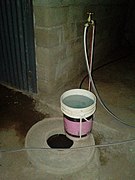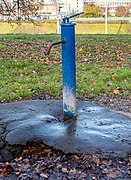Standpipe (street)

A standpipe is a freestanding pipe fitted with a tap which is installed outdoors to dispense water in areas which do not have a running water supply to the buildings.
Use
[edit]In the United Kingdom, an "Emergency Drought Order" permits a water company to shut off the primary water supply to homes, and to supply water instead from tanks or standpipes in the streets. This was done in some areas during the 1976 heat wave, for example.
In some Middle Eastern, Caribbean and North African countries a standpipe is used as a communal water supply for neighbourhoods which lack individual housing water service. In areas such as Morocco, standpipes often yield unreliable service and lead to water scarcity for large numbers of people.[1]
Freeze resistance
[edit]In areas where the air or surface ground temperatures reach below freezing point for part or all of the year, some standpipes are equipped with a feature whereby the same mechanism that valves the water for the bib also uncovers a drainage hole (the 'weep hole') at the base of the pipe when the standpipe is closed, ensuring that the column of water drains into the ground rather than remaining in the pipe where it might freeze and expand, bursting the plumbing. Standpipes that are equipped with this feature are sometimes referred to as 'frost-free hydrants' although frost buildup can still occur to a lesser extent.
Gallery
[edit]-
Standpipe in Helsinki
-
Street standpipe in Russia
-
Street standpipe in France
-
Standpipe at a backyard in Argentina
-
Street standpipe in Minsk
-
Typical Standpipe in Barbados
-
Standpipe in La Rose, Illinois, USA
References
[edit]- ^ Guillaume Benoit and Aline Comeau, A Sustainable Future for the Mediterranean (2005) 640 pages
External links
[edit]![]() Media related to Standpipes at Wikimedia Commons
Media related to Standpipes at Wikimedia Commons







